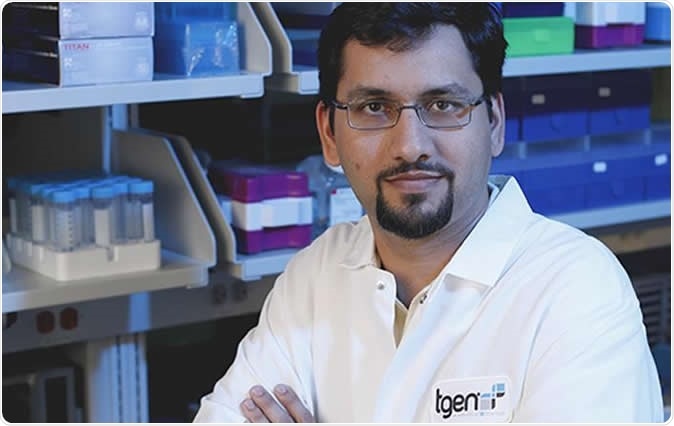Scientists have devised a newer form of blood test called TARDIS to diagnose breast cancer more accurately. This could help many thousands of women avoid needless breast biopsies and removals, as well as helping to follow up the treatment of breast cancer.
TARDIS or TARgeted DIgital Sequencing is claimed to be a hundred times more sensitive than any existing blood test for monitoring breast cancer. It is designed to pick up only the fragments of DNA that are shed from cancer cells into the blood. These bits of mutated DNA are called circulating tumor DNA (ctDNA), and can be detected at just 2 parts per 100,000 by the current test. First author Bradon McDonald says, “Fragments of ctDNA shed into blood by tumors carry the same cancer-specific mutations as the tumor cells, giving us a way to measure the tumor.”

Muhammed Murtaza, M.B.B.S., Ph.D., Assistant Professor and Co-Director of TGen's Center for Noninvasive Diagnostics. He also holds a joint appointment on the Research Faculty at Mayo Clinic in Arizona, and is one of the study's senior authors. Image Credit: Courtesy of TGen
The team focused on developing a ct-DNA-based test that could differentiate patients who no longer have cancer from those who have residual cancer following treatment. This distinction was conspicuously not being achieved by traditional tests including imaging. Other researchers have noted that in early or residual disease, the level of ctDNA is so microscopic that one blood sample cannot accurately detect any single mutation selected for screening. The current study got around this by incorporating many different mutations found in each patient’s tumor into one individualized test, making it capable of picking up any of these to reflect residual tumor. This gives it both high sensitivity and specificity.
Author Carlos Caldas calls this personalized test a “game changer for response monitoring and residual disease detection in early breast cancer treated with curative intent.”
Since this technique looks for cancer in a blood sample, rather than in fragments of solid tissue from a breast tumor, it is called a “liquid biopsy”. This makes it very much less invasive than a breast biopsy. Another point in its favor is its ability to reflect the presence of tumor at multiple sites with just one simple blood sample. It can therefore be repeated as required to follow up the disease, unlike biopsies which only show if tumor is present at the site chosen.
The extreme sensitivity of the test makes it far superior as a tool to detect the presence of tumor following drug therapy, compared to the currently used imaging tests. According to senior author Muhammed Murtaza, “By precisely measuring ctDNA, this test can detect the presence of residual cancer, and inform physicians if cancer has been successfully eradicated by treatment.” This is echoed by another researcher, Barbara A. Pockaj, who says, “This test could help plan the timing and extent of surgical resection and radiation therapy after pre-operative therapy.”
As a result, TARDIS could direct the physician to choose the right pathway of therapy very early in the course of treatment. By detecting traces of cancer, it helps decide whether pre-operative treatment should be continued, and to determine how well it has worked in eradicating the disease. In combination with imaging and other biomarkers, ctDNA detection is a very promising method for individualizing treatment decisions in patients with non-metastatic breast cancer.
Both overtreatment and undertreatment are known to occur in cancer, and both are hazardous to the patient. In the first, the patient is exposed to adverse effects, potentially dangerous, as a result of unnecessary treatment. In the second, the lack of adequate treatment means the cancer will relapse and eventually kill the patient. Thus, TARDIS could be of immense help in providing individualized treatment to cancer patients, says Murtaza.
The test needs further refining and must be validated in clinical tests as well as randomized trials. At that stage it could well transform the way breast cancer patients are monitored for the results of ongoing therapy.
Researcher Thomas Slavin notes an additional implication: “[By] reliably identifying, often multiple, circulating tumor mutations in the plasma of patients with non-metastatic breast cancer also holds promise that ctDNA may one day be a great tool for early breast cancer detection.”
The study comes from the Translational Genomics Research Institute (TGen) and Mayo Clinic (Arizona) campus and was published in the journal Science Translational Medicine on August 7, 2019.
Journal reference:
Personalized circulating tumor DNA analysis to detect residual disease after neoadjuvant therapy in breast cancer, Bradon R. McDonald, Tania Contente-Cuomo, Stephen-John Sammut, Ahuva Odenheimer-Bergman, Brenda Ernst, Nieves Perdigones, Suet-Feung Chin, Maria Farooq, Rosa Mejia, Patricia A. Cronin, Karen S. Anderson, Heidi E. Kosiorek, Donald W. Northfelt, Ann E. McCullough, Bhavika K. Patel, Jeffrey N. Weitzel, Thomas P. Slavin, Carlos Caldas, Barbara A. Pockaj, and Muhammed Murtaza1, Science Translational Medicine 07 Aug 2019: Vol. 11, Issue 504, eaax7392
DOI: 10.1126/scitranslmed.aax7392, https://stm.sciencemag.org/content/11/504/eaax7392